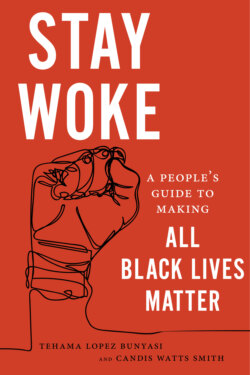Читать книгу Stay Woke - Candis Watts Smith - Страница 13
На сайте Литреса книга снята с продажи.
Education
ОглавлениеWhere one lives often influences where one goes to school. Schools are racially segregated, in large part, because housing is racially segregated. Racial effects are further exacerbated by class inequities rooted in racial disparities. Put simply, there has never been an instance when Black people who were isolated from whites got the same positive benefits from public schools that white people did.41 What makes the problem of the Black-white achievement gap in standardized testing scores such a fascinating problem to discuss is that anybody who knows anything about education policy knows that the problem can be largely fixed through racial integration. Needless to say, there is simply not enough political will to solve what seems to be a growing problem in the twenty-first century.
It’s not so much that Black students need to sit next to white ones to do better. It’s a matter of resources. Prior to the two Brown v. Board of Education of Topeka Supreme Court cases, “states spent very little on black schools relative to what they spent on white schools. Desegregation led to rapid increases in state spending on education, driven by white-controlled legislatures’ desires to ensure that white students’ school quality did not decline with integration.”42 With more resources, students have access to better teachers and materials and enjoy a lower student-to-teacher ratio. There are also indications that schools with more resources have a positive impact on both the students’ and teachers’ outlook on the educational process and learning environment.
The first Brown decision said that segregation was wrong and should be fixed. In the second Brown decision, the Supreme Court demanded that the states move faster to integrate schools. Northern and southern states alike moved slowly, but by the mid-1970s, several hundred school districts were under court-ordered desegregation plans. “Court-ordered desegregation was the single most important factor shaping the rapid declines in racial segregation in the 1960s and 1970s,” so much so that the threat of being under one of these orders influenced nonsupervised districts to initiate and implement their own integration policies.43 Once school districts began integrating through policies like busing, the achievement gap between Black and white students began to close. Voila!
At the peak of integration efforts around 1989, the achievement gap had closed significantly. Education scholars show that “from the early 1970s until the late 1980s, a very large narrowing of the [Black-white achievement] gap occurred in both reading and math. . . . For some cohorts, the gaps were cut by as much as half or more.”44 The effects of these policies have reverberated for two to three generations. Black students who desegregated schools between the 1960s and early 1980s were more likely to graduate from high school, to attend and graduate college, and to earn more money than those who attended segregated schools, and they were less likely to spend time in jail.45 Those who were exposed to schools that were desegregated due to court orders were less likely to be victims of homicide, arrested, or incarcerated. There were improvements to adult health outcomes, too. By the way, white students’ outcomes were not diminished in any way by school desegregation policies.46 School desegregation policies widened the geography of opportunity for a greater number of people.
Percentage of Black students in majority-white schools, 1954–2011. (Orfield et al., “Brown at 60,” 10)
What’s the status of integration now? In 1972 (during strong desegregation enforcement), about 25 percent of Black students in the South attended “intensely segregated schools in which nine out of 10 students were racial minorities,” but between 1990 and 2011 (during the decline in court orders), this number jumped up to 53 percent.47 This has occurred because of white flight, or the movement of white families to predominantly white districts or to private schools. Court orders primarily focus on within-district segregation, but they have little direct effect on between-district dynamics. As such, parents can move to racially homogeneous districts if they want their child to go to racially homogeneous public schools. Moreover, some neighborhoods and towns have pushed for the creation of new school districts in order to legally segregate schools (and to hoard resources). This is called educational gerrymandering.
Between 1990 and 2010, hundreds of school districts were released from court supervision and thus are no longer required to implement desegregation plans, which has hastened a new era of segregation. As such, most white schoolchildren go to schools that are largely white, and most Black and Latinx students go to majority-minority schools. The proportion of Black students going to majority-white schools nowadays mimics the figures from 1968! Appropriately, the term “apartheid schools” has been adopted to describe severely segregated schools, ones in which only 1 percent or less of the school population is white. Perhaps counterintuitively, many of these schools are in the Northeast and Midwest, and about 12 percent of students in the South attend these schools.48
Scholars have found that racial inequality has widened since the end of race-based busing efforts. Some have found that since the dismissal of these court orders, there has been an uptick in dropout rates among Black and Latinx students.49 Others show that both whites and students of color are likely to score lower on tests when they are assigned to predominantly minority schools and, further, that students are less likely to graduate high school or attend a four-year college.50 Scholars have expected inequality to increase as more court orders are dismissed, and cursory statistics from the US government provide evidence for this prediction. As we have seen before, poor Black and Brown children in isolated schools have not received the same opportunities as everyone else, and there is a growing population of students in that very vulnerable position.
Top-twenty most segregated states for Black students, 2011–2012. (Orfield et al., “Brown at 60,” 20)
Who goes to school with whom? (Orfield et al., “Brown at 60,” 12)
—
